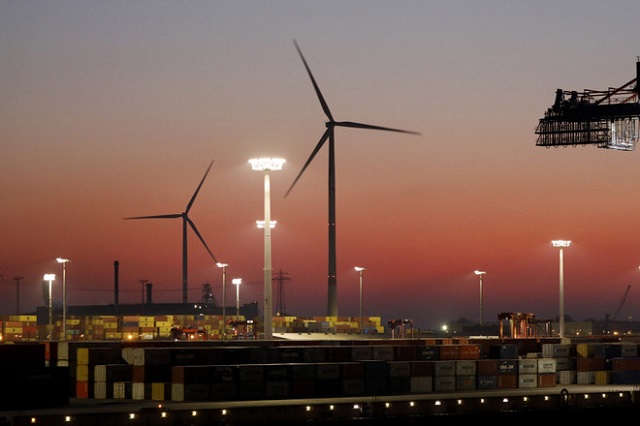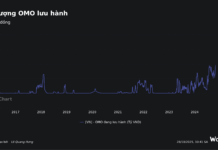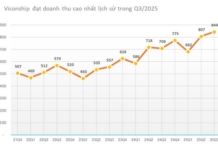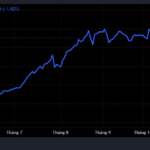
According to IMF predictions, the Vietnamese economy will reach a scale of US$506 billion in 2025, ranking 33rd globally. (Photo: AFP/VNA)
|
The global economy in 2025 will face the risk of heightened policy instability during a period that is already witnessing moderate growth.
The main reason for the Kiel Institute for the World Economy (IfW, Germany) to make this assessment is the announcements made by the incoming US administration, although the actual measures to be implemented are still unclear.
IfW’s forecast is based on the assumption that additional tariffs will be imposed on imports into the US, but the rates will not increase as sharply as President-elect Donald Trump proposed during his election campaign.
There is a consensus among the predictions of international financial organizations such as the International Monetary Fund (IMF), the World Bank (WB), and the Organization for Economic Cooperation and Development (OECD), as well as IfW, that global economic growth will be moderate in 2025.
IfW expects global Gross Domestic Product (GDP) growth to be 3.1%, while the IMF forecasts around 3.2%, and the WB gives a figure of 3.3%, compared to the corresponding 3.5% before the COVID-19 pandemic.
Goldman Sachs, although more optimistic, still only predicts “moderate” growth for next year. Global trade has shown signs of improvement this year but is likely to slow down significantly due to the restrictive trade policy measures expected to be imposed next year.

Consumers shop at a supermarket in California, the US, on April 10, 2024. (Photo: THX/VNA)
|
The re-election of billionaire Donald Trump with the slogan “Make America Great Again” and the “America First” policy are expected to bring about significant changes to the international economic landscape in 2025.
According to Pauline Wibaux, an economist at the French Institute for Research on Economic Perspectives and Policies (CEPII), “America First” has become a comprehensive economic strategy and has created a new protectionist trend. This is evident in the US’s continued high tariffs on Chinese goods and the enactment of laws such as the CHIPS and Science Act.
The European Union (EU) has also joined with its strategic autonomy policy based on the European Green Deal and measures to protect its internal market.
India imposed tariffs on imported solar panel products in 2018 to stem the influx of similar products from China.
Along with the rapid decline in EU-Russia trade, there is a risk of escalation in US-China trade tensions.
Trump is expected to take a tougher stance on China, which will have consequences for global trade flows as supply chains, sourcing, and transportation will eventually become more expensive, impacting consumers worldwide.
Experts assess that if the Trump administration increases tariffs, triggering a trade war, inflation could rise again, and the global economy could slow down or both could happen simultaneously. The unemployment rate, currently at a historical low, may increase.
Many other economies worry about the potential appreciation of the US dollar – if Trump’s policies lead to higher inflation and slow down the pace of Fed interest rate cuts, it could pull investment away from these countries and increase their US dollar-denominated debt.
Conflicts in Ukraine and the Middle East could affect energy costs, which fuel the world economy.
 Container port in Hamburg, northern Germany. (Photo: AFP/VNA)
|
Political stalemates in the two largest economies in the Eurozone, Germany and France, and doubts about the world’s second-largest economy, China, make the picture even gloomier. Meanwhile, the damage caused by climate change is becoming a top concern for many countries.
In its latest World Economic Outlook report, the IMF signaled, “Get ready for a volatile period.”
ECB President Christine Lagarde also noted in the bank’s recent meeting that there would be a lot of uncertainty in 2025.
However, the Ifo Institute in Munich believes that, overall, the global economy is likely to maintain a moderate growth trajectory in 2025 and 2026.
Higher trade tariffs are unlikely to take effect immediately after the new US president takes office but will instead occur throughout the next year, reinforcing existing trade diversionary activities, resulting in an increase in global trade in the first half of 2025, followed by a gradual slowdown.
Although IfW expects a slower pace of decline in US interest rates, the institute still anticipates that the global economy will gradually be boosted by more favorable financial conditions.
According to these assumptions, the US economy is likely to continue growing, while economic growth in Europe remains low. Meanwhile, a sustainable economic recovery in China is still not evident, despite the announced stimulus measures.
Andrea Coppola, World Bank’s Lead Economist and Program Manager for Equitable Growth, Finance, and Institutions for Vietnam, Laos, and Cambodia, opined that the economic outlook for 2025 is fundamentally positive. Although the two largest economies, the US and China, may slow down, this will be offset by a strong growth trend in the rest of the world, including Vietnam.
According to IMF predictions, the Vietnamese economy will reach a scale of US$506 billion in 2025, ranking 33rd globally.
HSBC assessed that Vietnam’s GDP growth in 2024 will reach 7% – the highest among the six largest economies in Southeast Asia, and in 2025, Vietnam’s GDP will continue to maintain the highest level in the region.
The Asian Development Bank (ADB) has upgraded its growth forecast for Vietnam in 2025 to 6.6% from 6.2% in September 2024.
Experts believe that flexible and adaptive economic policies are one of the keys to Vietnam’s continued success as an economic “bright spot.” It is also the “key” for economies to overcome the “headwinds” of 2025./.
Thu Hang
– 11:49 27/12/2024
3 Years of RCEP: Asserting the Role in an Open Economy
The Regional Comprehensive Economic Partnership (RCEP) is an ambitious free trade agreement between 15 countries, spanning from the vibrant markets of East and Southeast Asia to the economic powerhouses of Australia and New Zealand. This dynamic partnership brings together 10 member states of the Association of Southeast Asian Nations (ASEAN) alongside China, Japan, South Korea, Australia, and New Zealand.
The 2024 Total Budget Revenue Surpasses the Estimate by 17.4%
The year 2024 witnessed the relentless endeavors of the Ministry of Finance in executing the nation’s financial-budgetary tasks. With agile and assertive fiscal policies, budgetary revenue and expenditure achieved remarkable outcomes, significantly contributing to macroeconomic stability, inflation control, and social welfare assurance.
Sure, I can help you with that!
Title: CEBR: Vietnam Could Have Joined the High-Income Countries Group
The CEBR estimates that Vietnam’s per capita GDP in 2024 will reach $4,469. With this projection, Vietnam would ascend into the upper-middle-income country category, a testament to its remarkable economic progress.












































